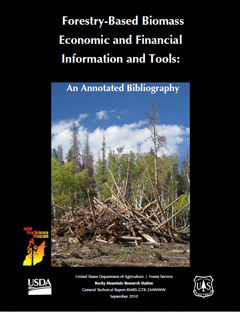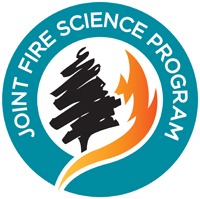Displaying 61 - 80 of 188
Mason, Lippke, Zobrist, Bloxton, Ceder, Comnick, McCarter, Rogers
ANNOTATION: Although large trees can be removed for valuable products, the market value for the smaller logs may be less than the harvest and hauling charges, resulting in a net cost for thinning operations. However, failure to remove these small logs…
Year: 2006
Type: Document
Source: FRAMES
Snider, Daugherty, Wood
ANNOTATION: This study shows that without large-scale implementation of fire hazard reduction treatments, the costs of uncharacteristic crown fires in southwest forests will continue to increase. They examined the economic rationality of continuing this…
Year: 2006
Type: Document
Source: FRAMES
Abt, Prestemon
ANNOTATION: This paper presents a model of interrelated timber markets in the U.S. West to assess the impacts of large-scale fuel reduction programs on these markets, and concomitant effects of the market on the fuel reduction programs. The model…
Year: 2006
Type: Document
Source: FRAMES
Silverstein, Loeffler, Jones, Calkin, Zuuring, Twer
ANNOTATION: The potential for biomass utilization to enhance the economics of treating hazardous forest fuels was examined on the Bitterroot National Forest and surrounding areas. Initial forest stand conditions were identified from Forest Inventory and…
Year: 2006
Type: Document
Source: FRAMES
Skog, Barbour
ANNOTATION: This paper identifies timberland areas in 12 western states where thinning treatments (1) are judged to be needed to reduce fire hazard and (2) may 'pay for themselves' at a scale to make investment in forest product processing a realistic…
Year: 2006
Type: Document
Source: FRAMES
Skog, Barbour, Abt, Bilek, Burch, Fight, Huggett, Miles, Reinhardt, Shepperd
ANNOTATION: The purpose of this report is to begin to identify locations in the west where fire hazard reduction treatments have a potential to 'pay for themselves' at a scale and over a long enough time to make investment in additional forest product…
Year: 2006
Type: Document
Source: FRAMES
Fight, Hartsough, Noordijk
ANNOTATION: FRCS is a spreadsheet application useful for estimating the cost of forest operations undertaken to reduce forest fuel loads by cutting and removing trees for solid wood products or chips. It can also be used to estimate the cost of collecting…
Year: 2006
Type: Document
Source: FRAMES
Calkin, Gebert
ANNOTATION: This report intends to increase the accuracy of cost data available for planning and prioritizing fuel management in national forests. A survey of fire management officers was used to develop regression models that may be used to estimate the…
Year: 2006
Type: Document
Source: FRAMES
Mitchell
ANNOTATION: This paper provides an overview of existing literature related to the harvest, communition and transport of forest residues. Past studies have investigated the systems associated with biomass harvesting. Researchers have explored whether to…
Year: 2005
Type: Document
Source: FRAMES
ANNOTATION: The authors of this synthesis have implemented several studies over the years, and this CD is an attempt to compile this data in a usable format. The Executive Summary has ten primary research topic areas related to biomass: Baling/bundling;…
Year: 2005
Type: Document
Source: FRAMES
Bolding, Lanford
ANNOTATION: This study examined and measured the feasibility of ground-based mechanical harvesting to reduce forest fuel buildup and produce energywood. It shows a cut-to-length harvesting system coupled with a small in-woods chipper provided a low impact…
Year: 2005
Type: Document
Source: FRAMES
Raymond, Peterson
ANNOTATION: The authors quantify the relationship between fuels and fire severity using pre-fire surface and canopy fuel data and fire severity data after a wildfire. Modeled fire behavior showed that thinning reduced canopy fuels, thereby decreasing the…
Year: 2005
Type: Document
Source: FRAMES, TTRS
Fight, Barbour
ANNOTATION: This paper discusses the My Fuel Treatment Planner (MyFTP) software to show the effect treatment variables have on the cost and net revenue from fire hazard reduction treatments in dry forest types of the Western United States. The study is…
Year: 2005
Type: Document
Source: FRAMES
Lowell, Larson, Rummer, Becker
Fuels reduction treatments generate a large amount of biomass, most of which is small in diameter. While this material may be suited for wood products, opportunities to process this material are few in the southwestern U.S. Harvesting and transportation…
Year: 2005
Type: Document
Source: FRAMES
Peterson, Johnson, Agee, Jain, McKenzie, Reinhardt
ANNOTATION: This document synthesizes the relevant scientific knowledge that can assist fuel-treatment projects on national forests and other public lands and contribute to National Environmental Policy Act (NEPA) analyses and other assessments. It is…
Year: 2005
Type: Document
Source: FRAMES, TTRS
Fried, Christensen, Weyermann, Barbour, Fight, Hiserote, Pinjuv
ANNOTATION: The FIA BioSum modeling framework that incorporates Forest Inventory and Analysis (FIA) plot data, a transportation cost model, a treatment cost accounting module, a log valuation model, and a crown fire hazard evaluator and was applied to a…
Year: 2005
Type: Document
Source: FRAMES
Johnson, Peterson
ANNOTATION: In order to accomplish complex and multiple management objectives related to forest structure, fuels, and fire disturbance, these two disciplines must be effectively integrated in science and practice. The authors have linked scientific and…
Year: 2005
Type: Document
Source: FRAMES, TTRS
Rawlings, Rummer, Seeley, Thomas, Morrison, Han, Cheff, Atkins, Graham, Windell
ANNOTATION: This study compares the costs of various slash transportation systems and found a roll on/off container system is not competitive with a regular highway chip van, unless part of that distance is inaccessible to the chip van. The roll on/off…
Year: 2004
Type: Document
Source: FRAMES
Rummer
ANNOTATION: This CD-ROM provides an overview of biomass issues, determining where bundling works and does not, developing productivity and cost estimates, and assessing properties and quality of bundled biomass for energy production. The objective of this…
Year: 2004
Type: Document
Source: FRAMES
Han, Lee, Johnson
ANNOTATION: In order to reduce the risk of wildfire in the Interior Northwest of the United States the economic feasibility of small wood thinning and utilization is considered in this article. The major factors influencing economic feasibility were…
Year: 2004
Type: Document
Source: FRAMES

